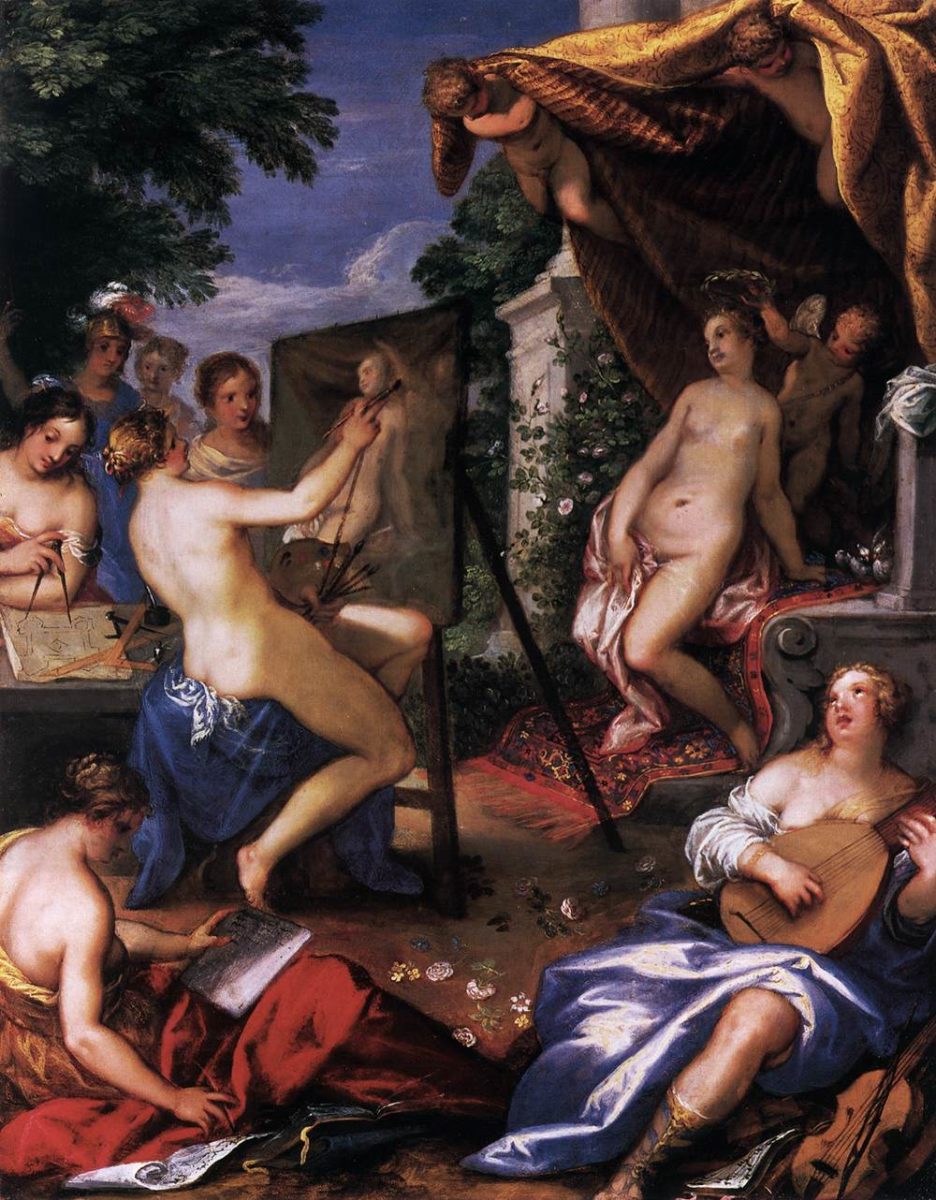by Katie Wilde
Artists are often asked “Does that pay the bills?” or “What’s your real job?”
True, it isn’t easy to make a living as a creative. Whether the field is performing, literary, visual, or media arts, most people aren’t going into it for the steady buck. But the arts contribute billions of dollars to Canada’s GDP, and account for over half a million jobs in a country with fewer citizens than the state of California. There are artists making money from their artistic job. So how are they doing it?
Hans Rottenhammer, Allegory of the Arts (second half of the 16th century). Gemäldegalerie, Berlin
This list is not exhaustive, but even if you’re a creative professional yourself there could be something that surprises you.
Selling a Physical Artistic Product
A ‘simple’ exchange of goods for money. Visual art and fine craft dominate this avenue, although audio/visual media, conceptual and performance art can also be purchased.
- Galleries: commercial, non-profit, co-op / artist-run-centres, public, vanity, alternative (cafés and businesses). There are many types of galleries offering widely different types of art. Some of it is for sale to buyers, some is bought by the gallery, some pay exhibition fees to artists, who get their work back after the show. In this article, Top Ten Ways Artists Make Money, artist Lori McNee explains more about different types of galleries.
- Out of Studio: If an artist doesn’t have formal gallery representation, they can sell work right from their studio and keep 100% of the sale. If they do have formal representation, selling from the studio is still an option, but it is ethical (sometimes binding by contract) for that artist to give their representative the same cut as sales from the gallery.
- Acquisitions: companies, governments and public galleries will make large-scale and one-off acquisitions of work for their permanent or eventually rotating collections.
- Art shows, fairs, and festivals: Summer and the winter holiday season tend to be the busiest times.
- Online: Besides selling directly from their own websites, Etsy, eBay, FineArtAmerica, and many many other websites sell art on behalf of artists. They vary in operation style and commission percentage.
Licensing and Royalties
Selling the rights to display, print, or play copies of creative work is one way to keep money coming in over and over for something that’s already created. This applies widely to visual arts, literary audio-visual media, theatre, performance, design, music, and just about anything you can think of! Unsurprisingly, it isn’t always the easiest or most obvious way to make money, and there are risks involved. Artists should consider talking to a pro or resource organization dealing specifically with licensing to develop a fuller understanding. There are some ways to license online that takes care of the nitty-gritty for artists, but researching the company is recommended before entering into any agreements or sending them work.
Merchandise
This category overlaps with the last when thinking about visual arts, but can form a key part of a band or musician’s income. The next time a band t-shirt seems like it costs too much, remember how much pirated music is out there, and how much the people whose work brought you joy could depend on these sales. Chances are you’ll also be supporting the artist they hired to do their album art and branding. Buy a t-shirt. Buy the CD.
Performance
Good old fashioned ticket sales continue to be a way performers or performance groups bring in funds. Remember that those sales have to go to pay the house, tech, marketing, artistic directors, etc. And when you pay to see a movie, it’s not just going to the star actor, but to the people designing costumes, holding mics, setting up lighting, editing, doing CGI, all of it. Don’t let the 1% of famous rock stars, comedians, actors and singers distract you from the millions of creative professionals who are also contributing to those works of art. I don’t feel bad saying it again, because this sector does depend enormously on the participation and restraint (from downloading) of almost all people. Buy something from the artists that made your movie night relaxing, your morning workout enjoyable, your wedding special or your grief bearable.
You can also show your appreciation with…
Donations and Tips – Kickstarter, Patreon, Tipping4Artists
Alternative consumption of media and art has forced the re-thinking of arts appreciation and compensation. More artists are combating the endless sharing of their work online by embracing their fans. Nobody means to share art maliciously, with the intent of robbing the artist of a living wage. If it’s being shared widely, it’s because it’s making an impression on people, and sharing is so darn easy. Performance artist Amanda Palmer shared perspective and method that is still relatively new in her TED talk “The Art of Asking“, which is well worth a watch. More artists are now giving their fans an opportunity to show support in whatever amount they choose through a donation, by becoming a Patreon, or by contributing to a Kickstarter to fund new work. The latter two offer tiered ‘rewards’ for the people contributing money.
Services
Artists find themselves becoming more and more of an expert in their field. This can take the form of technical understanding of tools, materials and process, industry experience, business skill, etc. Consulting for other artists, businesses and non-profits who need to access expertise on a project is one way to bring some money in, as is taking some form of employment which requires relevant skills and experience. Many of the people you find working at an art supply or music store, theatre company or publisher’s office are creative professionals in their own right.
There’s also freelance work to be had. It might be a side-step from an artist’s main practice, or might be their main practice, such as doing fancy chalkboards for restaurants and businesses, writing jingles, acting in commercials, illustrating textbooks, etc. I once met a girl who worked on horror films and created masks and prosthetics of monsters for movies. Very cool!
Commissions
Private commissions can be for ‘regular folk’ (as opposed to art collectors or film companies) who are looking for visual art that can be commemorative such as a picture of their kids, house, or dog. Sometimes artists are commissioned to create work in their own style, but with a theme or subject of the client’s choosing. This is often the case with public-facing commissions from government or business such as murals, sculptures, and monuments; with music for film and television; and with many writing gigs. Other times, an artist is given more free reign to create, for the sake of the art itself.
Competitions and Prizes
There are many, many competitions and prizes to be won for artistic creations. However, these can be a waste of time rather than a source of money. The difference for the artist will be knowing which prizes they are eligible for, suited for, and which offer a prize worth the effort it takes to apply. Then, apply for as many relevant and worthwhile prizes, as many times as possible, as you can. When the competition is also an exhibition, sale, or opportunity for relevant exposure, the worthwhile factor goes up.
Artists also retain the moral rights (copyright) to the work they create, unless the terms under which they were created specify otherwise (such as work for hire, or some commissions). This means that even after I sell you my painting, or my composition, I can still enter it in many contests, especially those that only require a digital format. It’s one way besides licensing and royalties that an artist can continue to make a creative work bring in money after it has sold.
Grants and Bursaries
Governments (at all levels), non-profits, and businesses that recognize the value of the arts can and do provide funding to artists in various disciplines. They can be competitive, but there are resources to help potential applicants learn grant-writing skills and find available funding. Grants are typically awarded for a specific project or body of work, to help it start, develop, or finish. Recipients can be required to report the spending of the money, show results, and return unspent or misspent money. Bursaries are similar, but generally less rigorous in the reporting and timelines, and are a bit like an award in that they are partly awarded in recognition of worthwhile work already completed, or to fund an educational or professional opportunity.
Residencies
These opportunities vary from a few days to a year or more, but are designed for a combination of give and take between the artist and the host. The host can be a government, arts group, or business, who might provide any or all of the following: workspace, living space, creative seclusion (this is a good thing), networking opportunities with other artists and industry professionals, mentors, and the public, teaching opportunities, tools, funding, etc. In return they will sometimes ask for you to produce certain work, offer teaching or speaking engagements to their community, participate in programs, etc. Some residencies charge for the opportunity, and can be considered more of an educational expense.
Books
There are plenty of book genres available to artists who aren’t writers. These include coffee-table books of photography and other visual art, about film, instructionals, humour books, and entertainment pieces about the wild exploits of performers, to offer a few examples. Some are self-published hard copies paid for up front and sold off slowly by the artist themselves, or ebooks for paid download or as part of a Patreon or Kickstarter campaign. Some are picked up by a publisher and earn through royalties.
Teaching
Many artists also teach. For some, it’s not just an income source, but an opportunity to continue learning, encourage passion and skill in the arts, and give back to a generation of emerging artists. Part time teaching opportunities can be found with private schools for all ages such as the Guelph School of Art, with non-profits, governments, and community programs, in the school system at the elementary, secondary and post-secondary levels, and as a freelance tutor.
I read somewhere that if the career path of a lawyer is like bamboo, then an artist’s is like ivy – exploring different routes, figuring out what sticks, and growing persistently.
The artists that make a go of it professionally have put in countless hours, made many sacrifices and mistakes, jumped through hurdles and faced rejection, but never stop developing themselves. Here’s to them!








